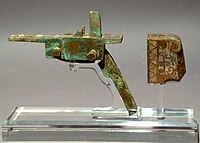
Photo from wikipedia
OBJECTIVES Rapid prototyping (RP) technology is becoming more affordable, faster, and is now capable of building models with a high resolution and accuracy. Due to technological limitations, 3D printing in… Click to show full abstract
OBJECTIVES Rapid prototyping (RP) technology is becoming more affordable, faster, and is now capable of building models with a high resolution and accuracy. Due to technological limitations, 3D printing in biological anthropology has been mostly limited to museum displays and forensic reconstructions. In this study, we compared the accuracy of different 3D printers to establish whether RP can be used effectively to reproduce anthropological dental collections, potentially replacing access to oftentimes fragile and irreplaceable original material. METHODS We digitized specimens from the Yuendumu collection of Australian Aboriginal dental casts using a high-resolution white-light scanning system and reproduced them using four different 3D printing technologies: stereolithography (SLA); fused deposition modeling (FDM); binder-jetting; and material-jetting. We compared the deviations between the original 3D surface models with 3D print scans using color maps generated from a 3D metric deviation analysis. RESULTS The 3D printed models reproduced both the detail and discrete morphology of the scanned dental casts. The results of the metric deviation analysis demonstrate that all 3D print models were accurate, with only a few small areas of high deviations. The material-jetting and SLA printers were found to perform better than the other two printing machines. CONCLUSIONS The quality of current commercial 3D printers has reached a good level of accuracy and detail reproduction. However, the costs and printing times limit its application to produce large sample numbers for use in most anthropological studies. Nonetheless, RP offers a viable option to preserve numerically constraint fragile skeletal and dental material in paleoanthropological collections.
Journal Title: American journal of physical anthropology
Year Published: 2018
Link to full text (if available)
Share on Social Media: Sign Up to like & get
recommendations!